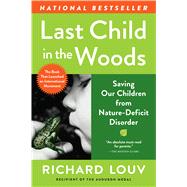
Note: Supplemental materials are not guaranteed with Rental or Used book purchases.
Purchase Benefits
What is included with this book?
| Acknowledgments | p. xi |
| Introduction | p. 1 |
| The New Relationship Between Children and Nature | |
| Gifts of Nature | p. 7 |
| The Third Frontier | p. 15 |
| The Criminalization of Natural Play | p. 27 |
| Why the Young (and the Rest of Us) Need Nature | |
| Climbing the Tree of Health | p. 39 |
| A Life of the Senses: Nature vs. the Know-It-All State of Mind | p. 55 |
| The "Eighth Intelligence" | p. 71 |
| The Genius of Childhood: How Nature Nurtures Creativity | p. 86 |
| Nature-Deficit Disorder and the Restorative Environment | p. 99 |
| The Best of Intentions: Why Johnnie and Jeannie Don't Play Outside Anymore | |
| Time and Fear | p. 115 |
| The Bogeyman Syndrome Redux | p. 123 |
| Don't Know Much About Natural History: Education as a Barrier to Nature | p. 133 |
| Where Will Future Stewards of Nature Come From? | p. 146 |
| The Nature-Child Reunion | |
| Bringing Nature Home | p. 163 |
| Scared Smart: Facing the Bogeyman | p. 178 |
| Telling Turtle Tales: Using Nature as a Moral Teacher | p. 189 |
| The Jungle Blackboard | |
| Natural School Reform | p. 203 |
| Camp Revival | p. 227 |
| Wonder Land: Opening the Fourth Frontier | |
| The Education of Judge Thatcher: Decriminalizing Natural Play | p. 237 |
| Cities Gone Wild | p. 245 |
| Where the Wild Things Will Be: A New Back-to-the-Land Movement | p. 271 |
| To Be Amazed | |
| The Spiritual Necessity of Nature for the Young | p. 291 |
| Fire and Fermentation: Building a Movement | p. 307 |
| While It Lasts | p. 315 |
| Notes | p. 317 |
| Suggested Reading | p. 329 |
| Index | p. 333 |
| A Field Guide to Last Child in the Woods | p. 345 |
| Table of Contents provided by Ingram. All Rights Reserved. |
The New copy of this book will include any supplemental materials advertised. Please check the title of the book to determine if it should include any access cards, study guides, lab manuals, CDs, etc.
The Used, Rental and eBook copies of this book are not guaranteed to include any supplemental materials. Typically, only the book itself is included. This is true even if the title states it includes any access cards, study guides, lab manuals, CDs, etc.